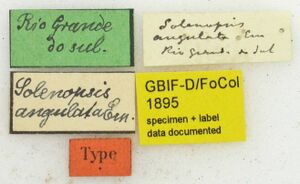Carebara angulata
| Carebara angulata | |
|---|---|

| |
| Scientific classification | |
| Kingdom: | Animalia |
| Phylum: | Arthropoda |
| Class: | Insecta |
| Order: | Hymenoptera |
| Family: | Formicidae |
| Subfamily: | Myrmicinae |
| Tribe: | Crematogastrini |
| Genus: | Carebara |
| Species: | C. angulata |
| Binomial name | |
| Carebara angulata Fernández, 2004 | |
The type material was collected from a forest litter sample.
Identification
Fernández (2004) - A member of the Carebara escherichi species complex. This species is easily recognized by its promesonotal sculpturation. The anterior half is more or less longitudinally striated and the posterior half densely reticulated. In side view, the propodeum forms a slightly angle between the dorsal and sloping faces. The head has four hairs near the occipital corners.
Keys including this Species
Distribution
Latitudinal Distribution Pattern
Latitudinal Range: 0.5° to -0.6364°.
| North Temperate |
North Subtropical |
Tropical | South Subtropical |
South Temperate |
- Source: AntMaps
Distribution based on Regional Taxon Lists
Neotropical Region: Colombia (type locality), Ecuador.
Distribution based on AntMaps
Distribution based on AntWeb specimens
Check data from AntWeb
Countries Occupied
| Number of countries occupied by this species based on AntWiki Regional Taxon Lists. In general, fewer countries occupied indicates a narrower range, while more countries indicates a more widespread species. |

|
Estimated Abundance
| Relative abundance based on number of AntMaps records per species (this species within the purple bar). Fewer records (to the left) indicates a less abundant/encountered species while more records (to the right) indicates more abundant/encountered species. |

|
Biology
Castes
Worker
   
| |
| . | |
Queen
   
| |
| . | |
Nomenclature
The following information is derived from Barry Bolton's Online Catalogue of the Ants of the World.
- angulata. Carebara angulata Fernández, 2004a: 226, figs. 8J, 11) (w.) COLOMBIA, ECUADOR.
- Type-material: holotype worker, 3 paratype workers.
- Type-locality: holotype Colombia: Nariño, Orito, Kofán Territory, 00°30’N, 77°13’W, 1000 m., 25.ix.1998, Winkler trap, forest litter (E.L. González); paratypes: 1 worker Colombia: Nariño, Jardines de Sucumbíos, Kofán Territory, Rumiyaco-Rancheria cross rivers, 1000 m., 00°28’N, 77°17’W, Winkler trap, forest litter (E.L. González), 2 workers Ecuador: Napo, Limoncocha, 00ã24’S, 76°36’W, 20.vii.1973, no. 5300 (C.W. Rettenmeyer).
- Type-depositories: IAVH (holotype); IAVH, MZSP (paratypes).
- Status as species: Fernández & Serna, 2019: 822.
- Distribution: Colombia, Ecuador.
Unless otherwise noted the text for the remainder of this section is reported from the publication that includes the original description.
Description
Worker
Holotype (Paratypes n=2): HW 0.31 (0.31); HL 0.36 (0.35); SL 0.19 (0.18); PW - (0.20-02.4); WL 0.29 (0.27-0.28); GL 0.36 (0.34-0.35); TL 1.24 (1.20-1.22); CI 86 (88); SI 60 (58). [The bad mounting of de ecuatorian paratype prevents some measurements. The scapes and legs are broken].
As. Carebara inca with the following differences:
A longitudinal and less narrow stripe, subopaque. Eyes reduced to 1-2 ommatidia. Propodeum slightly angulated. Propodeal spiracle circular, spiracle low and nearly in contact with bullae of metapleural gland. Dorsum of head densely sculptured with deep foveolated punctures whose diameters are smaller than the spaces separating them; dorsum of promesonotum anteriorly with a very fine and irregular longitudinal rugulae, posteriorly with dense and well-marked reticulae, somewhat more widely spaced in propodeal dorsum; sloping face of propodeum without transverse rugulae. Gaster smooth and shining. Dorsum of head with fine appressed pubescence, dorsal promesonotum with only a little appressed pubescence; rest of body without. Short curved and scattered pubescence on femora and tibiae. Long hairs (more or less three times longer than short hairs) few and distributed as follows: four in the clypeal medial area; two over each frontal carinae; four on the posterior part of head (two on each side, near the occipital border); twelve on promesonotal dorsum; two on propodeal dorsum; two (and four medium size) on the petiole, four on the postpetiole, several scattered on tergal dorsum; more or less four median dorsal hairs on each tibia. Body brown, gaster darker.
Type Material
Holotype worker. COLOMBIA. Nariño: Orito, Kofán Territory, 00°30’N 77°13’W, 1000 m, Winkler trap in forest litter, 25 sep 1998, E. L. González, deposited in Humboldt Institute. Paratypes. COLOMBIA. Nariño: 1 worker, Jardines de Sucumbíos, Kofán Territory, Rumiyaco-Ranchería cross rivers, 1000 m, 0°28’N 77°17’W, Winkler trap in litter forest, E.L. González, IAVH; ECUADOR. Napo, 2 workers, Limoncocha, 00°24’S 76°36’W, 20 jul 1973, C.W. Rettenmeyer No. 5300, Museu de Zoologia da Universidade de Sao Paulo.
References
- Fernández, F. 2004a. The American species of the myrmicine ant genus Carebara Westwood (Hymentoptera: Formicidae). Caldasia. 26(1):191-238. (page 226, figs. 8J, 11 worker described)
References based on Global Ant Biodiversity Informatics
- Fernández, F. and S. Sendoya. 2004. Lista de las hormigas neotropicales. Biota Colombiana Volume 5, Number 1.

